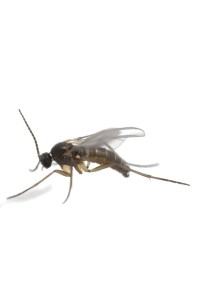Threats:
- Known to spread diseases like Anthrax, Cholera, Salmonella, Tuberculosis, Typhoid, Dysentery, and others
- Can spread over 100 known pathogens
- Can cause food poisoning
- Will spread bacteria to food products
- Cannot bite or sting
Habits:
- Outside can be seen on plants, fences, trash cans, the ground, vehicles, the side of a home, compost piles, and more
- Indoors can be seen resting on nearly any surface and buzzing through the structure, even landing on humans
- Prefers to rest near sources of food from 4-10 feet off the ground
- Commonly plague outdoor events, especially those with food
- They are known to infest poultry coups when feces is allowed to build up
Reproduction and Lifecycle:
House flies undergo complete metamorphosis with four distinct stages: egg, maggot (larva), pupa, and adult. Musca domestica can overwinter in the larval and pupal stages, especially where manure piles or other sources of warmth may be located. In warm conditions, the metamorphosis can be completed in just 7 -10 days, whereas in cooler, less hospitable conditions, as much as two months may be necessary. In regions like Kentucky and Tennessee, 10 – 12 generations may be hatched yearly.
Eggs
Eggs are roughly 1.2mm long. They are laid by the female one at a time in groups or piles of 75 -150. The female will lay approximately 500 eggs in 3 – 4 days, and several females may lay their eggs near one another.
Larva
Larva begin at about 4-9mm long and are cylindrical with an off-white color. The body tapers toward the head, which has a set of hooks. As a full-grown maggot, the larvae see three instars, finally reaching 6-12mm. They begin feeding as soon as they hatch and develop within 3-13 days if conditions are favorable or 13-30 days if conditions are less hospitable.
Areas with high nutrient availability, like manure, compost piles, or sand and soil rich with nutrients, provide optimal conditions for larva development. Once fully developed, the mature maggot might crawl 5 – 50 feet away to a cool, dry place with abundant breeding material. Here, the maggot will continue metamorphosis into the pupal stage.
Pupa
Once maggots begin the pupal stage, the last larval exoskeleton is used to form a pupal case in which the stage will complete. The shape now takes on a more oval appearance. This stage will last 2 – 6 days in optimal conditions or 30 days in less favorable conditions. Once completed, the adult fly emerges from the pupal casing using the ptilinum on its head’s front. The ptilinum swells and shrinks, acting like a hammer beating against the pupal case until it breaks through.
Adult
Females are around 6 – 7 mm long, while males tend to be smaller. Males and females are easy to tell apart if observed with magnification, especially. The eyes of a male almost touch together, while females have a definitive space between their eyes.
Nests and Colonies:
House flies neither nest nor colonize. However, it has been estimated that under optimal conditions, one pair of mating flies could potentially produce as many as 191,010,000,000,000,000,000 (191 quintillion) offspring between April and October.
Flies develop in large numbers quite commonly, especially in places like poultry, dairy, and other similar farms. A structure stationed nearby, such as a farm or other favorable environment, may see heavy infestations suddenly and for an extended period. Often, those situations are tough to eliminate since the source of the infestation is out of your control.
Preventative Measures:
- Sanitation, sanitation, sanitation.
- No food or other materials should be left where flies can lay eggs.
- Remove wet manure from farms a minimum of twice per week.
- Remove wet straw from any setting near a building.
- Straw is a strong breeding ground for flies. Please don’t use it as bedding.
- Garbage cans and dumpsters should have tight-fitting lids.
- Garbage receptacles should be located away from structures.
- All garbage should be placed in plastic bags and tightly sealed before discarding.
- Window screens must be in good repair.
 https://i0.wp.com/www.myfsps.com/wp-content/uploads/2025/07/The_Larval_Stage_Of_Pests_And_Why_It_Matters_In_Structural_Pest_Control_Featured_Image.jpg?fit=700%2C381&ssl=1
381
700
Matthew Hess
https://www.myfsps.com/wp-content/uploads/2023/01/Logo-Four-Seasons-Pest-Solutions-Pest-Control-300x94.png
Matthew Hess2025-07-25 06:41:492025-07-20 13:58:16The Larval Stage of Pests and Why It Matters in Structural Pest Control
https://i0.wp.com/www.myfsps.com/wp-content/uploads/2025/07/The_Larval_Stage_Of_Pests_And_Why_It_Matters_In_Structural_Pest_Control_Featured_Image.jpg?fit=700%2C381&ssl=1
381
700
Matthew Hess
https://www.myfsps.com/wp-content/uploads/2023/01/Logo-Four-Seasons-Pest-Solutions-Pest-Control-300x94.png
Matthew Hess2025-07-25 06:41:492025-07-20 13:58:16The Larval Stage of Pests and Why It Matters in Structural Pest Control
 Scientific Name: Musca Domestica
Scientific Name: Musca Domestica











 Four Seasons Pest Solutions
Four Seasons Pest Solutions Four Seasons Pest Solutions
Four Seasons Pest Solutions
You must be logged in to post a comment.